

GROUP DYMAMICS
Lidong Feng a, b, Xinchao Bian a, b, **, Gao Li a, Zhiming Chen b, Xuesi ChenPolymer Degradation and Stability 125 (2016) 148e155Lidong Feng a, b, Xinchao Bian a, b, **, Gao Li a, Zhiming Chen b, Xuesi Chen

A series of novel biodegradable polyurethanes (PELU) based on poly(ethylene glycol)-b-polylactide copolymers were prepared by chain extension with isophorone diisocyanate (IPDI). The PELUs were used to toughen polylactide (PLA) by melt blending. The results of DSC and SEM uniformly indicated that the PELUs were partially compatible with PLA and the PLA segments in PELU could effectively improve the compatibility between PLA and PELU. PELU as a plasticizer could significantly improve the toughness of PLA materials and remain their high strength and modulus. When the PELU content was 10e20 wt%, the elongation at break of PLA/PELU-40/ADR (0.4 wt%) and PLA/PELU-50/ADR (0.4 wt%) reached up to 250% e350%. When the PELU content was 20 wt%, the tensile strength and modulus of PLA blends containing PELU-30, PELU-40 and PELU-50 maintained 35e38 MPa and 1300e1500 MPa, respectively. The moisture absorption of the PLA materials enhanced because of blending with PELU containing PEG segments, but the hydrolytic degradation property of PLA materials was little affected by this.